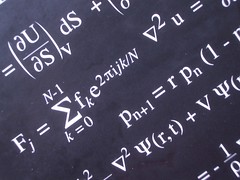 |
In a preprint On a ℤ₂ⁿ-Graded Version of Supersymmetry I construct a “higher” graded version of the extended supersymmetry algebras and construct the corresponding generalisation of Minkowski superspace. |
Supersymmetry is a powerful non-classical symmetry that relates bosons and fermions. A geometric understanding of this can be found under the umbrella of “superspace” methods, which rely on the theory of supermanifolds. At a basic level, one starts with Minkowski space-time and then appends to this anticommuting spinor coordinates. By anticommuting we mean that
θ1 θ2 = – θ2 θ1
The fact that we append object that anticommute is deeply tied to that fact that quasi-classically, fermionic fields require us to use such weird things. This is really a form of the Pauli exclusion principle.
However, from a mathematical point of view, there is no reason why we cannot append spinors with more exotic relations between them. Indeed, people have considered “non-anticommuting superspaces” inspired by the way string theory should modify space-time on the smallest scales. In the preprint, I consider a very mild version of this non-anticommutativity by appending spinors that commute (i.e., the order does not matter) up to a sign given by a ℤ₂ⁿ-grading.
This leads to spinors that square to zero (as they should), yet commute amongst themselves! This is very different from the standard theory of supermanifolds and supersymmetry. In fact, we are immediately reminded of Green-Volkov parastatistics. I comment on this in the preprint, though parastatistical versions of “superspace” were not my main motivation with this work.
It seems that just about everything can be generalised to this higher graded setting using the theory of ℤ₂ⁿ-geometry, which is itself a new and developing piece of mathematics. In particular, a higher graded version of Minkowski superspace is given and the corresponding supersymmetry transformations are explored in the preprint.